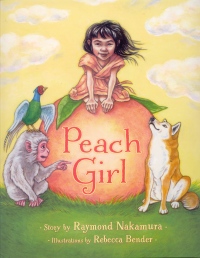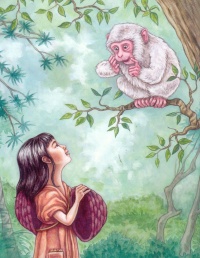| ________________
CM . . .
. Volume XX Number 41. . . .June 20, 2014
excerpt:
Although delighted with Momoko’s appearance, the farmer and her husband fear for her safety. He warns Momoko of the dangerous ogre, but undaunted, this plucky young girl has only concern – to improve the world. The couple make good use of the peach girl’s birth place to fashion a helmet and shield for protection and the peach flesh, itself, to make peach dumplings for food to sustain her on this ambitious quest. Along the way, Momoko enlists the help of a monkey, a dog, and a pheasant, wisely using the peach dumplings as an enticement. All three recruits give the peach girl ominous warnings of the ogre’s large size, his sharp teeth and the eyes that “shoot flames”, with an emphasis on the fact that “he eats small children”. The creative trio of animals and Momoko fashion a boat to transport them to the castle. The real fun starts when they come face to face with the dreaded ogre. Readers will enjoy the surprise, “peachy” ending.
Recommended. Reesa Cohen is a retired Instructor of Children’s Literature and Information Literacy at the Faculty of Education, University of Manitoba in Winnipeg, MB.
To comment
on this title or this review, send mail to cm@umanitoba.ca.
Copyright © the Manitoba Library Association. Reproduction for personal
use is permitted only if this copyright notice is maintained. Any
other reproduction is prohibited without permission.
NEXT REVIEW |
TABLE OF CONTENTS FOR THIS ISSUE
- June 20, 2014.
AUTHORS |
TITLES |
MEDIA REVIEWS |
PROFILES |
BACK ISSUES |
SEARCH |
CMARCHIVE |
HOME |

 This tale gets its inspiration from a popular piece of Japanese folklore, The Peach Boy, the Legend of Momotaro. It is said to be ancient Japan’s equivalent of Superman, a cultural icon and hero for children and adults alike. Nakamura’s imaginative but slimmer version, features a gender twist and is lighter and somewhat quirky, with a fearless, daring heroine. But it is told with humour and charm, and the repetition lends a lyrical quality to the story.
This tale gets its inspiration from a popular piece of Japanese folklore, The Peach Boy, the Legend of Momotaro. It is said to be ancient Japan’s equivalent of Superman, a cultural icon and hero for children and adults alike. Nakamura’s imaginative but slimmer version, features a gender twist and is lighter and somewhat quirky, with a fearless, daring heroine. But it is told with humour and charm, and the repetition lends a lyrical quality to the story.